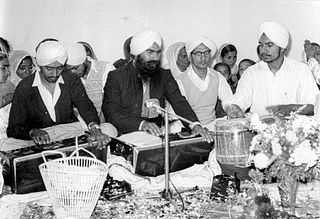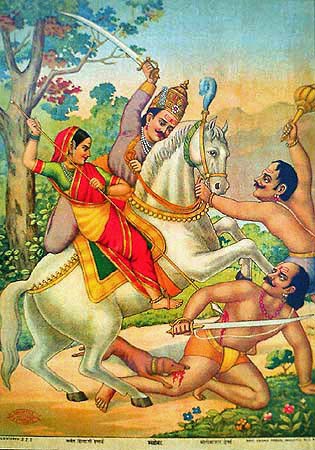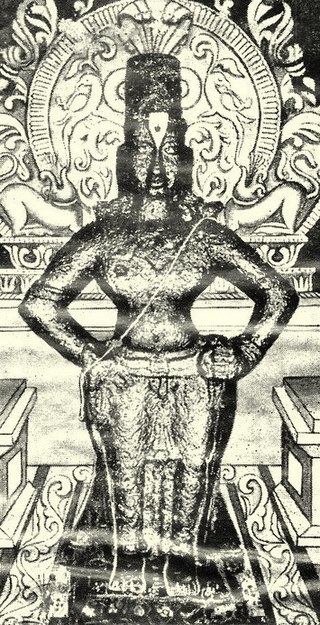Related Research Articles

Shiva , also known as Mahadeva, is one of the principal deities of Hinduism. He is the Supreme Being in Shaivism, one of the major traditions within Hinduism.

Kirtana, also rendered as Kirtan or Keertan, is a Sanskrit word that means "narrating, reciting, telling, describing" of an idea or story, specifically in Indian religions. It also refers to a genre of religious performance arts, connoting a musical form of narration or shared recitation, particularly of spiritual or religious ideas, native to the Indian subcontinent.

Basava, also called Basaveshwara and Basavanna, was a 12th-century CE Indian statesman, philosopher, poet, Lingayat social reformer in the Shiva-focussed bhakti movement, and a Hindu Shaivite social reformer during the reign of the Kalyani Chalukya/Kalachuri dynasty. Basava was active during the rule of both dynasties but reached the peak of his influence during the rule of King Bijjala II in Karnataka, India.

Dattatreya, Dattā or Dattaguru, is a paradigmatic Sannyasi (monk) and one of the lords of yoga, venerated as a Hindu god. He is considered to be an avatar and combined form of the three Hindu gods Brahma, Vishnu, and Shiva, who are also collectively known as the Trimurti, and as the manifestation of Parabrahma, the supreme being, in texts such as the Bhagavata Purana, the Markandeya Purana, and the Brahmanda Purana, though stories about his birth and origin vary from text to text. Several Upanishads are dedicated to him, as are texts of the Vedanta-Yoga tradition in Hinduism. One of the most important texts of Hinduism, namely Avadhuta Gita is attributed to Dattatreya. Over time, Dattatreya has inspired many monastic movements in Shaivism, Vaishnavism, and Shaktism, particularly in the Deccan region of India, Maharashtra, Gujarat, Madhya Pradesh, Rajasthan and Himalayan regions where Shaivism is prevalent. His pursuit of simple life, kindness to all, sharing of his knowledge and the meaning of life during his travels is reverentially mentioned in the poems by Tukaram, a saint-poet of the Bhakti movement.
Om Namah Shivaya is one of the most popular Hindu mantras and the most important mantra in Shaivism. Namah Shivaya means "O salutations to the auspicious one!", or "adoration to Lord Shiva". It is called Siva Panchakshara, or Shiva Panchakshara or simply Panchakshara meaning the "five-syllable" mantra and is dedicated to Shiva. This Mantra appears as 'Na' 'Ma' 'Śi' 'Vā' and 'Ya' in the Shri Rudram Chamakam which is a part of the Krishna Yajurveda and also in the Rudrashtadhyayi which is a part of the Shukla Yajurveda.
Mahanubhava refers to Krishnaite Hindu denomination in India that was founded by Sarvadnya Shri Chakradhar Swami ,an ascetic and philosopher who is considered as a reincarnation of Krishna by his devotees Some sources list the founders as Chakrapani and Govinda Prabhu with Chakradhara as the first "apostle" and propagator of Mahanubhava Pantha. Mahanubhava Sampradaya was formally formed in modern-day Varhad region of Maharashtra in 1267 CE. It has different names such as Jai Krishni Pantha in Punjab and Achyuta Pantha in Gujarat. Mahanubhava Pantha was also known as Paramarga by its followers in 13th century. Nagadevacharya, also known as Bhatobas, became the head of Sampradaya after Chakradhara.

Omkareshwar is a Hindu temple dedicated to Shiva, located in Mandhata, nearby Khandwa city in Khandwa district of the Indian state of Madhya Pradesh. It is one of the 12 revered Jyotirlinga shrines of Shiva. It is on an island called Mandhata, near Khandwa city in the Narmada river at Khandwa district in Madhya Pradesh, India; the shape of the island is said to be like the Devanagari ॐ symbol.

Khandoba, also known as Martanda Bhairava,, Malhari and Malhar, is a Hindu deity worshiped as a manifestation of Shiva mainly in the Deccan plateau of India, especially in the state of Maharashtra and North Karnataka. He is the most popular Kuladevata in Maharashtra. He is also the patron deity of some warrior, farming castes, shepherd community and Brahmin (priestly) castes as well as several of the hunter/gatherer tribes that are native to the hills and forests of this region. The sect of Khandoba has linkages with Hindu and Jain traditions, and also assimilates all communities irrespective of caste, including Muslims. The character of Khandoba developed during the 9th and 10th centuries from a folk deity into a composite god possessing the attributes of Shiva, Bhairava, Surya and Kartikeya (Skanda). He is depicted either in the form of a linga, or as an image of a warrior riding on a bull or a horse. The foremost centre of Khandoba worship is the temple of Jejuri in Maharashtra. The legends of Khandoba, found in the text Malhari Mahatmya and also narrated in folk songs, revolve around his victory over demons Mani-malla and his marriages.

Vithoba, also known as Vitthala, and Panduranga, is a Hindu god predominantly worshipped in the Indian state of Maharashtra and Karnataka. He is a form of the god Vishnu. Vithoba is often depicted as a dark young boy, standing arms akimbo on a brick, sometimes accompanied by his consort Rakhumai.

The Devi Bhagavata Purana, also known as the Srimad Devi Bhagavatam, Srimad Bhagavatam, Bhagavata Purana or simply Devi Bhagavatam, is one of the eighteen Mahapuranas of Hinduism. Composed in Sanskrit by Veda Vyasa, the text is considered as a major purana for Devi worshippers. It promotes bhakti (devotion) towards Mahadevi, integrating themes from the Shaktadvaitavada tradition.

Nageshwara Jyotirlinga is one of the twelve Jyotirlings, which are temples devoted to Shiva. The Nageshwara Jyotirling is located in Aundha Nagnath, Maharshtra. Some individuals believe that the Dwarka Shivalinga in gujrat represents the Nageshwara Jyotirlinga.
Yenathinathar, also known as Yenatinata, Yenathi Nayanar, Yenadhinatha, Yenadinath, Yenadinatha Nayanar and Yenadhinatha Nayanar, was a Nayanar saint hailing from ezhakula Channar clan, venerated in the Hindu sect of Shaivism. He is generally counted as the ninth in the list of 63 Nayanars. In 1901, P.Sv. Perumal Nadar formed Srimath Yenathinadha Nayanar Thirumadalayam at Aruppukottai
Narahari Sonar or Narharidas was a 13th-century Hindu poet-saint of the Varkari sect and goldsmith (sonar) from Maharashtra, India. His hagiography speaks about his transition from a staunch Shaiva to a Vithoba-worshipping Varkari after a miracle that makes him realize that Vithoba and Shiva are one and the same.

Sheikh Muhammad (1560–1650), also known as Shekh Mahammad (Mohammad), Sayyad Shaikh Mahammad Qadiri, Shaikh Muhammad Shrigondekar (lit. Sheikh Muhammad of Shrigonde), and Sheikh (Shekh) Mahammad-baba, was a Muslim saint-poet who is venerated by Hindus. He is considered the most well-known Marathi Muslim poet. He is the author of the Yoga-samgrama (Yoga-sangrama).

rudrakṣajābāla upaniṣat, also known as Rudraksha Jabala Upanishat, Rudraksha jabalopanishat, Rudraksha Upanishat and Rudrakshopanishat, is one of 108 Upanishadic Hindu scriptures, written in Sanskrit language. It is dedicated to the Rudraksha, a seed used as prayer beads, which is sacred to the god Shiva. The scripture belongs to the Shaiva sect, which worships Shiva, and is associated with the Samaveda, and is one of 14 Shaiva Upanishads. It is told as a conversation between Kalagni Rudra, a form of Shiva and Sage Sanatkumara.
Shridhar Brahmanand Nazarekar, popularly known as Shridhar Swami Nazarekar or Shridhar Pandit, was a popular Marathi Akhyanaka (narrative) poet and philosopher who wrote several caritra granthas in the 17th and 18th centuries. Shridhara was a puranik, that is one who recite stories from Puranas. Later he began to compose works himself in a simple devotional style, and were not only extremely popular, but were revered and worshipped like sacred texts.
Shri Ram Vijaya is a popular devotional literature composed by Shridhar Swami Nazarekar (1658-1729) in Marathi. It literally means 'Victory to Rama, an incarnation of Vishnu'.
HariVijaya is a devotional literature composed by Shridhar Swami Nazarekar (1658-1729), a popular Marathi poet in the 17-18th century. It literally means 'Victory to God Hari'.
References
- ↑ Shivlilamrut. Sahitya Sangam. 2000.
- ↑ Lokrajya, Volume 37. Directorate-General of Information and Public Relations. 1981.
- ↑ Dinakar Dhondo Karve (1963). The New Brahmans: Five Maharashtrian Families . University of California Press. p. 19.
He mentions Harivijay (Victory to God Hari [Shiva]), Ramavijay (Victory to Rama, an incarnation of Vishnu), Shivlilamrit (The Nectar of Shiva's Play), and Laghu-Guru-Charitra (The Story of Guru [the God Dattatreya]). These collections of legends about gods and supernatural figures are typical of traditional Marathi vernacular literature. The first three are by Shridhar (1678- 1728), the most prolific of marathi poets.
- ↑ "Complete text of Shivlilamrut".
- ↑ Maharashtra State Gazetteers: Botany. pt. 1. Medicinal plans. pt. 2. Timbers. pt. 3. Miscellaneous plants. pt. 4. Government of Maharashtra. 961. p. 485.
Rudraksha. A large tree found in Konkan and Kanara ghats. The five grooved and elegantly tubereled nuts are worn in the form of necklaces by Shivabhaktas (worshipper or followers of Shiv) in order to obtain Shivloka (heaven wherein the god Shiv resides), and to gain his graces. A good account relating to this practice is found in Shivlilamrut